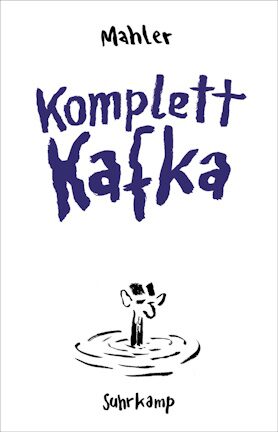Nicolas Mahler
Komplett Kafka
[Completely Kafka]
- Suhrkamp Verlag
- Berlin 2023
- ISBN 978-3-518-47374-0
- 127 Pages
- Publisher’s contact details
Published in Italian with a grant from Litrix.de.
Franz Kafka through the eyes of a cartoonist
Given that Kafka’s darkly enigmatic stories also contain a great deal of (absurd) humor,
it is only fitting that the Austrian comic artist and cartoonist, Nicolas Mahler, has chosen to tackle Kafka’s life and work on the 100th anniversary of his death: “Complete Kafka” is the resonant title of his new book. Yet, can one do justice to the complexity of the German-Jewish writer from Prague within the span of a 100 pages, while also preserving his humor? “Mahler”, as the illustrator calls himself for short, proves it can be done and delivers a solid and entertaining introduction to Kafka’s biography, his thinking and to his most important works.
This is not the illustrator’s first artistic encounter with world literature: whether Marcel Proust’s “Search for Lost Time”, James Joyce's “Ulysses” or Robert Musil's “Man without Qualities” - Mahler, who was born in 1969, has “transformed” all of these milestones of modernism into compact comic versions. He contrasts their monumental narrative with bits of poignant and satirical hyperbole. In 2021, he also created a subtle “comic biography” of the Austrian playwright Thomas Bernhard. Mahler's interpretations of literary classics are favorites of the arts section of the newspapers and creates apt distillations with their own artistic value. Not least because of his unmistakable minimalist, caricature style, Mahler also holds a firm place in the German-language comic scene. His trenchant black humor with its distinctly Austrian style fits perfectly to his bizarre little manikins which aptly expose human weaknesses.
“Komplett Kafka” can certainly be seen as a highlight in Mahler's series of literary adaptations. Formally, it is not a pure comic, rather it is a biographical narrative with illustrations and cartoons. Mahler succinctly sums up Kafka’s life, occasionally commenting on it with subtle irony, but mostly allowing Kafka to speak for himself. The illustrator looks at Kafka the man, his roots in the German-Jewish community in Prague, as well as the self-doubt that plagued him his entire life. This tendency is best reflected, among other things, in the famous “Letter to his Father”. While Kafka himself is depicted as a thin line with elephant ears, Mahler portrays his father Hermann as a monstrous, powerful golem, the renowned Jewish mystical figure. The biographical passages are often interrupted by cartoons and comic sequences that humorously interpret Kafka's novels and stories such as “The Metamorphosis” or “Hunger Artist”. Mahler detects a relationship between Kafka’s novel “The Castle” and Friedrich Wilhelm Murnau’s vampire film “Nosferatu”, both of which were made around 1922. For each quotation used, Mahler also lists the respective source in the book’s appendix.
Mahler draws on Kafka’s diaries and letters as well as Max Brod’s memoirs. His portrayal of Kafka’s desperate and tragicomic efforts to form a relationship with his fiancée Felice Bauer is particularly touching. The zealous letter writer appears to us today as a flawed human being. Particularly amusing are the quotes from critical reviews that were written by Kafka’s contemporaries, who mostly failed to recognize his genius and condemned, “The Metamorphosis” as “lacking fantasy and boring”. Mahler also mentions the fairly unknown and unauthorized sequel to the story, which was written in 1920 by the “fan” Karl Brand. In his version, Gregor Samsa, who had been transformed into a beetle, has a happy ending in that he metamorphoses back into a human again.
Mahler’s vivacious pen and ink drawings, executed with thick brushstrokes, skillfully quote and parody Kafka’s own drawings, which were often abstracted studies of individual characters. The Austrian enjoys disrupting Kafka’s abysmal world with bits of silliness. The profound anguish that marked Kafka’s life, which was plagued by illness, and which can be seen in many of his texts is rendered bearable through Mahler’s ironic and lovingly empathetic look at the torments of his soul. In “Complete Kafka”, the writer of the century lands on the dissecting table of a humorist whose illustrations are no less ingenious than his subject.

By Ralph Trommer
Ralph Trommer, Dipl. Animator, is a freelance writer and artist who is a regular contributor of reviews and articles on comics, graphic novels and films for a variety of media.
Publisher's Summary
Franz Kafka not only wrote prose, he was also passionate about drawing: »Did you know I was once a great drawer,« he wrote about his artistic ambitions, half ironic, half proud, to his fiancée Felice Bauer in 1913. Drawing had at one time »satisfied him more than anything else«. So what could be more appropriate than to honour him on his anniversary with a comic biography? By no other than Nicolas Mahler, whose cultivates drawing style is similarly minimalist?
In his inimitably witty and pointed manner, Mahler portrays Kafka’s life and work and does not shy away from the big questions: Why did Kafka’s plan to write a series of cheap travel guides fail? Who wrote the sequel to one of his most important works, »The Retransformation of Gregor Samsa«? And what was the »white slave« all about? The answers to this and much more can be found in Completely Kafka.
(Text: Suhrkamp Verlag)
